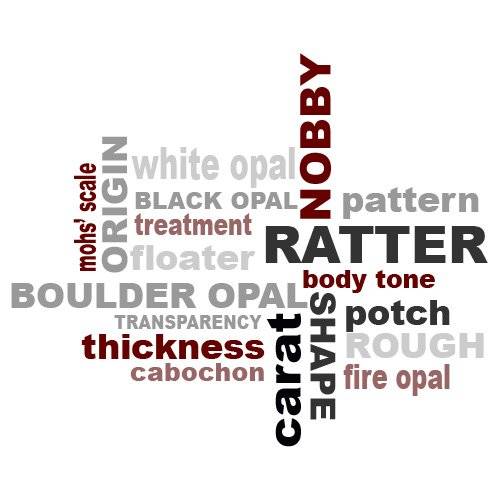A Guide to Common Opal Words

When you are searching for opals on our site, you may come across many unfamiliar terms. For instance, you might be wondering about the difference between a black opal, a semi-black opal and a white opal. You might have even heard words like floaters, noodling or ratters in relation to opals. Here is a brief guide to the most common terms associated with opals:
Black opal: The most precious form of opal, found mainly in Lightening Ridge, New South Wales. The black body tone comes from a high carbon and iron oxide content. The name is not a reference to the colours displayed by the opal.
Body tone: Opals are rated on a body tone from N1 to N9. Opals having a body tone of N1-N4 are called black opals, those having a body tone of N5-N6 are called semi-black opals and finally, opals having a body tone of N7-N9 are called light opals.
Boulder opal: An opal formed when silica deposits in the cavities and cracks of an ironstone boulder. The ironstone is left on the back and it is cut and polished along with the opal.
Cabochon: Opals are opaque precious stones, so they are given a cabochon cut, unlike transparent precious stones like diamonds which are given faceted cuts. The opal is shaped and polished to give it a domed and convex surface.
Carat: A carat is a unit of weight for a gemstone. One carat is one-fifth of a gram.
Fire Opal: The name 'Fire Opal' is usually used to refer to Mexican Fire Opals. However, any opal that has a brilliant flash or 'fire colours' can be called a fire opal. The name is not commonly used in Australia.
Floater: An opal, which has eroded from its host rock and was found on the surface is called a floater. If found on ground-level, it indicates that there is a source of opal nearby.
Mohs' Scale: An international scale to measure the hardness of a gemstone and distinguish between different kinds of gemstones.
Nobby: An opal which has a natural lump shape is called a nobby. It is found only at Lightening Ridge.
Ratter: A person who poaches opals from someone else's mine. If the person is caught, he could be severely punished.
Rough: A raw opal that has not been cut yet.
Potch: A colourless or common opal. It is non-precious and does not contain any ‘play of colour’.
White opal: An opal which has a body tone of N7-N9 (light or white in colour). It is usually found in South Australia.


